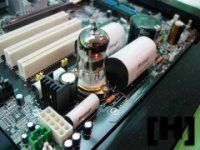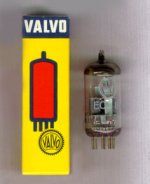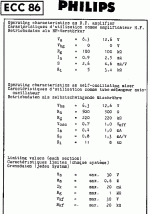I found yesterday this thread where a motherboard manufacturer is using tubes on their motherboard as a low power amplifier.
Computer with integrated tube amp
Do you have any schematics on low voltage tube amplifier ?
What are your impressions about the 6922 used as a low power amplifier ?
Thank you !

Computer with integrated tube amp
Do you have any schematics on low voltage tube amplifier ?
What are your impressions about the 6922 used as a low power amplifier ?
Thank you !

Attachments
Ahhh, the triumph of marketing.
The 6922 will not be particularly linear with a low plate supply. A Nuvistor would have been a better choice if such things were still made. I'm still in hysterics about the marketing-driven idea that after running the signal through thousands of transistor junctions, Everything Will Be OK if we put a tube somewhere in the line. Looks cool, but so would the same tube with just the filaments powered up. Just as useful, too.
The 6922 will not be particularly linear with a low plate supply. A Nuvistor would have been a better choice if such things were still made. I'm still in hysterics about the marketing-driven idea that after running the signal through thousands of transistor junctions, Everything Will Be OK if we put a tube somewhere in the line. Looks cool, but so would the same tube with just the filaments powered up. Just as useful, too.
ON THE BRIGHT SIDE...
Hi,
All marketing aside,I now that for line level stages the 6DJ8 family can be run successfully at 24 V B+.
Italian Stefano Pugini has once presented a complete 24 VDC battery powered preamp using the 6DJ8.
If you like to take a look:
PAENG
I can only assume that on the MB from Aopen they run it at a very low B+ .
Cheers,
Hi,
All marketing aside,I now that for line level stages the 6DJ8 family can be run successfully at 24 V B+.
Italian Stefano Pugini has once presented a complete 24 VDC battery powered preamp using the 6DJ8.
If you like to take a look:
PAENG
I can only assume that on the MB from Aopen they run it at a very low B+ .
Cheers,
STRANGE TACTICS
Hi,
Could very well be...only 300 VDC for a 6922 is way too much.
Does anyone know the function of that tube there?
Cheers,
Hi,
The other thread stated that a 300V DC to DC converter was being used.
Could very well be...only 300 VDC for a 6922 is way too much.
Does anyone know the function of that tube there?
Cheers,
Re: STRANGE TACTICS
Yes. Marketing.
300V as a supply is not necessarily too much, and isn't too different that what I use in my own preamp/xover. The critical thing is what voltage ends up at the plate- which you well know. If you're going to run a tube in that 6DJ8 family in a linear way, you need current- with a 20K plate resistor (pretty moderate value) and 10 ma of zero-signal current, you'd end up with 100V on that plate, pretty close to that tube's sweet spot. Likewise, 50K and 4 ma, though the gain/linearity tradeoff would be an interesting one.
Yes, you CAN run tubes in the 6DJ8 family at low plate voltages (24V was your example), but for swings of a couple of volts, the distortion will be higher than good engineering practice will tolerate. Maybe that's what some designers are after, but it's not hi fi, it's signal processing.
fdegrove said:
Does anyone know the function of that tube there?
Yes. Marketing.
300V as a supply is not necessarily too much, and isn't too different that what I use in my own preamp/xover. The critical thing is what voltage ends up at the plate- which you well know. If you're going to run a tube in that 6DJ8 family in a linear way, you need current- with a 20K plate resistor (pretty moderate value) and 10 ma of zero-signal current, you'd end up with 100V on that plate, pretty close to that tube's sweet spot. Likewise, 50K and 4 ma, though the gain/linearity tradeoff would be an interesting one.
Yes, you CAN run tubes in the 6DJ8 family at low plate voltages (24V was your example), but for swings of a couple of volts, the distortion will be higher than good engineering practice will tolerate. Maybe that's what some designers are after, but it's not hi fi, it's signal processing.
Marketing
Studer once made a studio analogue to digital convertor that included a valve which was visible through a window in the front panel. The heaters didn't glow enough, so an orange LED was mounted in the centre of the valve socket to add a bit more glow. I don't know what electrical function the valve performed (if any), but the unit had a control labelled "Angel Zoom." I kid you not.
Studer once made a studio analogue to digital convertor that included a valve which was visible through a window in the front panel. The heaters didn't glow enough, so an orange LED was mounted in the centre of the valve socket to add a bit more glow. I don't know what electrical function the valve performed (if any), but the unit had a control labelled "Angel Zoom." I kid you not.
A tube radio, output stage operating from 12VDC B+
A tube radio with a "power" output stage operating from 12VDC B+
the 1st audio tube. You may have to select a somewhat different value to get good audio. The tube used here is another 12V tube, the 12AE6.
The amount of audio output power isn't much, about 50mW. Similar to that of a transistor radio. The output tube is a space charge tetrode, a 12K5. Except for pin 5, it will fit the same socket connections as a 50C5. Pin 2 is the control grid, and pins 5 and 6 of the 12K5 are the space charge grid, which connects to B+. This tube was intended for output stage transistor driver circuits in car radios.
12 V Tube radio
12 V Valves from the 1950-ies
Low-voltage phono preamplifier by Stefano Perugini
A tube radio with a "power" output stage operating from 12VDC B+
the 1st audio tube. You may have to select a somewhat different value to get good audio. The tube used here is another 12V tube, the 12AE6.
The amount of audio output power isn't much, about 50mW. Similar to that of a transistor radio. The output tube is a space charge tetrode, a 12K5. Except for pin 5, it will fit the same socket connections as a 50C5. Pin 2 is the control grid, and pins 5 and 6 of the 12K5 are the space charge grid, which connects to B+. This tube was intended for output stage transistor driver circuits in car radios.
12 V Tube radio
12 V Valves from the 1950-ies
Low-voltage phono preamplifier by Stefano Perugini
In the world of the vacuum tubes it is inusual to meet with devices able to work at a low power supply. Among the signal triodes it is natural to think about the ECC86/6GM8; with its maximum plate voltage of only 30 volts, a transconductance and an internal resistance of 3.6 mA/V and 7K respectively, it represents the canonical choice when you want to elaborate the audio signal at low levels an low power supply. A series of experiments convinced me that, however, the use of valves, apparently not suitable for this aim, as the E88CC/6922 and E188CC/7308 (very similar tubes but not the same), can produce better results from the sonic point of view even at a low power supply. Between the two, I have fully preferred the E188CC/7308 because in this appliance I have found a better alectric response and a more pleasant sonic feature.
ECC86/6GM8
ECC86/6GM8
ECC86 datasheet PDF
Headwize Tube Amp uses ECC86/6GM8
halo - the low voltage tubeman
--------------------------------------
ECC86/6GM8
ECC86 datasheet PDF
Headwize Tube Amp uses ECC86/6GM8
An externally hosted image should be here but it was not working when we last tested it.
halo - the low voltage tubeman
--------------------------------------
Attachments
THANKS BUT NO THANKS.
Hi,
Thanks for the info Carl but let me tell you upfront that I wouldn't spend a single penny on the ECC86.
The ECC88 family of tubes sound much better under similar conditions.
If you want to go tubes,think of PSU voltages in the order of 200 to 450 VDC for sonic bliss.
Cheers,
\You can't turn a sows' ear into a silk purse.
Hi,
Thanks for the info Carl but let me tell you upfront that I wouldn't spend a single penny on the ECC86.
The ECC88 family of tubes sound much better under similar conditions.
If you want to go tubes,think of PSU voltages in the order of 200 to 450 VDC for sonic bliss.
Cheers,
\You can't turn a sows' ear into a silk purse.
Yeah, this is the same marketing scheme used by many musician accessory companies here in the US. Almost all of the "tube" microphone preamps aimed at amateurs use 20-30V on the plates of a single 12AX7 to add "tube warmth". This is another way of saying distortion figures approaching 15-20%.
I'd rather have a well-designed solid-state device than one of these "hybrid" pieces of gimmickry.
Unfortunately, a lot of this mythology crosses over into the hi-fi world. We've all seen posters asking how they can add a tube to something to "warm it up".

I'd rather have a well-designed solid-state device than one of these "hybrid" pieces of gimmickry.
Unfortunately, a lot of this mythology crosses over into the hi-fi world. We've all seen posters asking how they can add a tube to something to "warm it up".

Doubtfull result with very low voltage TUBES
Thanks for clarifying this after my posts.
When I say that there are tubes that can be used at 12-30 V,
I do no mean to say it is to prefer.
More of an experiment to see how to hook up tubes.
-----------------------------------------------------------
I have asked other who knows, if I can use these low voltage tubes
for audio. They have said the same thing. There is no point to!
They have been polite/patient not to say:
"You are stupid! or Forget it!
What I have understood, we have to go up to at least
something like 100 volt, to get tubes that work well.
But still they have a hard time to match high voltage tubes
or transistors.
/halo - for better sound he stays Solid State
- until he goes high voltage Tube
Joel.Joel said:Almost all of the "tube" microphone preamps aimed at amateurs use 20-30V on the plates of a single 12AX7 to add "tube warmth". This is another way of saying distortion figures approaching 15-20%.
I'd rather have a well-designed solid-state device than one of these "hybrid" pieces of gimmickry.
Thanks for clarifying this after my posts.
When I say that there are tubes that can be used at 12-30 V,
I do no mean to say it is to prefer.
More of an experiment to see how to hook up tubes.
-----------------------------------------------------------
I have asked other who knows, if I can use these low voltage tubes
for audio. They have said the same thing. There is no point to!
They have been polite/patient not to say:
"You are stupid! or Forget it!
What I have understood, we have to go up to at least
something like 100 volt, to get tubes that work well.
But still they have a hard time to match high voltage tubes
or transistors.
/halo - for better sound he stays Solid State

- until he goes high voltage Tube

VOLTAGES.
Hi,
The ECC86/6GM8 is a tube that is specifically design for use in low voltage designs.
It will not even work with much more then 30 V on its' plate.
Whether or not you like the way it sounds will much depend on what you want to use it for.
There are other tubes out there that were designed for this particular use but not all that many.
Obviously the ECC83/12AX7A was never designed with this kind of application in mind.
Cheers,
\Frank,definitely sticking with higher voltage valves.
Hi,
The ECC86/6GM8 is a tube that is specifically design for use in low voltage designs.
It will not even work with much more then 30 V on its' plate.
Whether or not you like the way it sounds will much depend on what you want to use it for.
There are other tubes out there that were designed for this particular use but not all that many.
Obviously the ECC83/12AX7A was never designed with this kind of application in mind.
Cheers,
\Frank,definitely sticking with higher voltage valves.
- Status
- This old topic is closed. If you want to reopen this topic, contact a moderator using the "Report Post" button.
- Home
- Amplifiers
- Tubes / Valves
- Low voltage Tube Schematic


